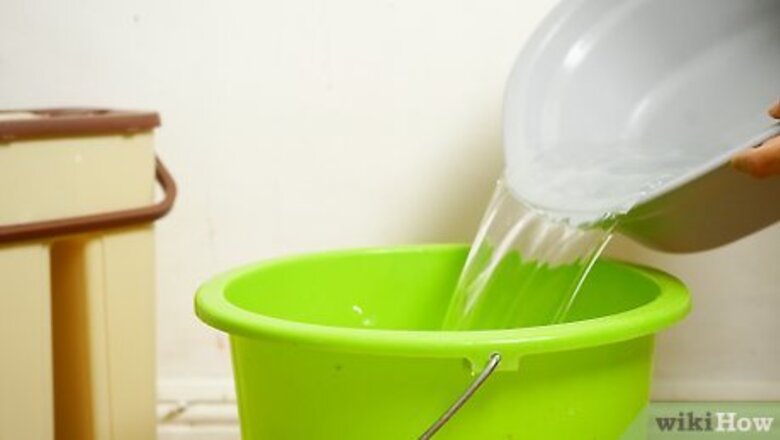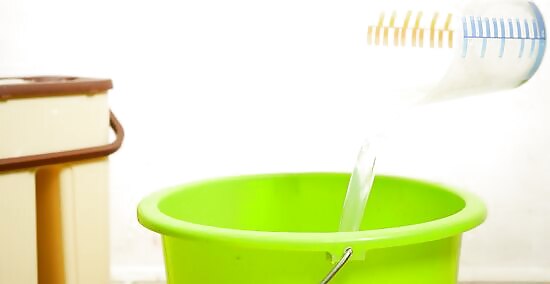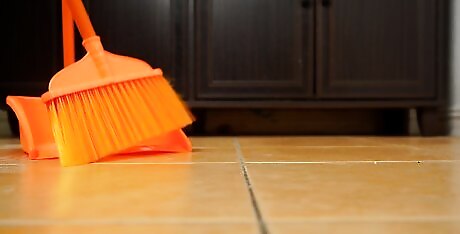
views
Mopping Tile Floors with Vinegar

Fill a bucket with hot water. For most floors, one or two gallons of water will suffice. If you need to clean a larger area, you can add an extra couple of gallons incrementally. The warmer the water, the better it will be for loosening stuck-on dirt and grime. Before you start mopping, make sure you've cleared the floor of all removable furniture, appliances and other objects that might get in the way or be damaged by water. If the bucket is too big to fit under the sink, try filling it your bathtub.

Add a cup of distilled white vinegar. Aim for a ratio of roughly ½ to 1 cup of vinegar for every gallon of water. Swish the vinegar solution gently to make sure it’s blended. Vinegar is mildly acidic, which makes it useful for dissolving hardened residue. Diluting the vinegar will prevent it from bleaching the color or wearing down the finish of your floor tiles. Other high-potency types of vinegar, such as apple cider vinegar, will also get the job done.
Mop the tiles with the vinegar solution. Work your way across the tiles, mopping in a circular or side-to-side direction. Make sure to spread the vinegar over the entire surface of the floor. Don’t forget to run the mop beneath nearby furniture and along the baseboards. As you mop, you should be able to see the results of the vinegar right away. Be careful not to saturate bordering wood or carpet flooring with the vinegar solution.
Rinse the floor with fresh water. Empty the bucket and refill it with clean, warm water. Go back over the floor once more, wringing out and rewetting the mop every few feet. This will help clear the tiles of loose residue and any remaining traces of vinegar. Soak up excess water with the mop, a squeegee or an absorbent towel, then allow it to air dry completely. If you skip the rinsing step, the dingy water will dry on the floor, leaving behind streaks and splotches. Making sure that the grout has a chance to dry out is essential for preventing the growth of mold and mildew, which thrive in warm, moist spaces.
Deep-Cleaning Grout with Vinegar and Baking Soda
Combine warm water and vinegar in a spray bottle. Use equal quantities of both liquids and shake well to mix. The spray bottle will give you greater control over the application of the vinegar, which will be helpful when cleaning narrow spaces like grout lines. A spray bottle of vinegar is a convenient natural cleaning solution to have around in a pinch.
Sprinkle baking soda along one section of grout lines. You won’t need to use much—a thin dusting will be fine. Work the baking soda into the grout using your fingertips or the bristles of a brush. For maximum efficiency, proceed in small squares, following the grid-like pattern of the grout a few feet at a time. For particularly bad stains, you can also mix up a paste of baking soda and water, apply it to the grout and leave it to take effect overnight.
Spray the baking soda with the vinegar solution. Together, the two ingredients will start a mild chemical reaction, creating a fizzy foam that will bubble over the grout. Allow the baking soda and vinegar to sit for 5-10 minutes to ensure that it’s had time to eat away at the worst of the buildup. This foaming action will make it much easier for the vinegar and baking soda combination to penetrate down into the tiny pores of the grout. To get the most out of the mixture’s stain-lifting power, wait until the foaming has died down before you begin scrubbing.
Scrub the grout clean. Using a stiff-bristled brush, scour the grout and space between the edges of the tiles forcefully. After the vinegar and baking soda treatment, you should be able to lift out even the heaviest stains. Once you’re finished, give the floor a thorough rinse using a wet rag or sponge, then leave it to air dry. Special brushes designed for cleaning grout can be bought cheap at all home improvement stores. Alternatively, you might also use a long-handled kitchen dish scrubber. Repurpose an old toothbrush and use it to clean grout. The narrow head of the brush coupled with the long handle makes it the perfect tool for getting down into the spaces between tiles. Scrubbing grout by hand can be time-consuming, but it’s without a doubt the most effective means of restoring it to its original color.
Maintaining Your Tile Floor

Clean tile floors regularly. When it comes to maintaining tile, the best solution is prevention. By sweeping, vacuuming and polishing your flooring on a consistent basis, there will be less chance of stain-causing substances accumulating underfoot. Be on the lookout for places where dirt and debris have a tendency to collect, especially in corners, beneath furniture and around the baseboards. Aim to sweep or vacuum your tile floors every couple of days, and to mop or give them a more extensive wipedown about once a week. Neglected tile will quickly begin to advertise itself. If you allow it to get bad enough, it may even negatively affect the value of your home.
Wipe up spills and messes right away. When left untreated, even the smallest spill can become a stubborn stain. As promptly as possible, blot the affected area with a clean cloth dampened with warm water or a small amount of vinegar solution. Tracked-in dirt and food particles should be swept up so they don’t get ground into grout or rough surfaces. Gradually apply more vinegar as need until the stain begins to come out. Responding to messes quickly is especially important if you have light-colored tile or grout that make discoloration more noticeable.
Avoid using chemical cleaners. Tile is praised for its durability and ease of cleaning, but it’s not indestructible. Harsh chemicals like bleach can cause natural materials to fade, while astringent cleaners may ruin the smooth finish of porcelain tiles after only a few uses. Whenever possible, opt for mild green alternatives such as vinegar and baking soda instead. Even commercial tile cleaners can take their toll when used frequently, and are usually no more effective than garden variety vinegar, anyway. Never use anything more abrasive than a stiff-bristled brush or kitchen sponge to scrub your tile floors. Doing so may leave behind small scratches in which dirt and mildew can set up for good.

















Comments
0 comment